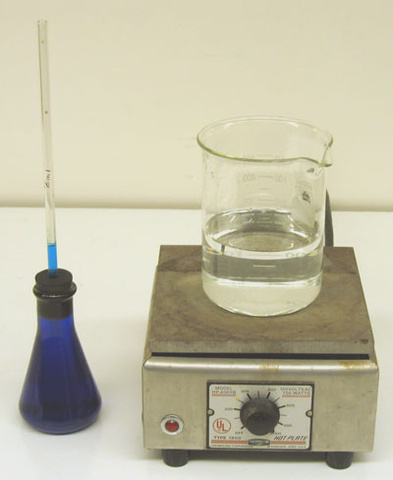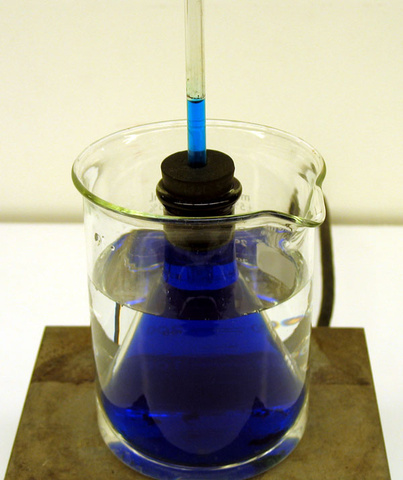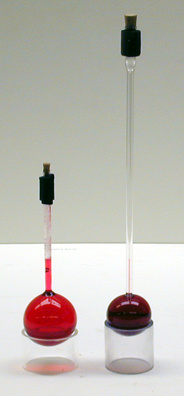Breadcrumb
4A20.10 - Expansion & Contraction Demo - Liquids

|

|

|
Code Number: 4A20.10
Demo Title: Expansion & Contraction Demo - Liquids
Condition: Good
Principle: Expansion & Contraction with Temperature Variation
Area of Study: Thermodynamics
Equipment:
Bunsen burner, Gloves, Beaker (1000 mL) with water (800 mL), Flask (125 mL) with stopper & capillary, Colored water, Ring stand with asbestos pad, Matches.
Procedure:
Fill the beaker with colored water and insert the stopper with the glass tube through it. The water level should rise in the glass tube so that you can see it above the stopper. Apply heat and the liquid should expand and rise in the tube. Cool the liquid and the level should go downward in the tube.
The glass air thermometer tubes are filled with colored water. Additional water may have to be added as necessary. Heating the bulb in a water bath will expand the fluid into the tube and the expansion can be calibrated to any temperature scale.
References:
- Shizhuo Luo, Minghui Ma, Zhongping Wang, Lazhen Sun, Zengming Zhang, "Measuring the Expansion Coefficient of Water Using Lloyd's Mirror", TPT, Vol. 62, #4, April 2024, p. 278.
- C. T. Haywood, "Temperature and the Transfer of Heat", TPT, Vol. 14, #6, Sept. 1976, p. 366.
- George M. Hopkins, "Reflection and Concentration of Heat", Experimental Science, p. 192.
- George M. Hopkins, "Air Thermometer", Experimental Science, p. 184.
- A. D. Bulman, "Thermoscopes", Model-Making for Physics, p. 18.
- Charles Vivian, "Expansion Race", Science Experiments & Amusements For Children, p. 81.
- Charles Vivian, "A Simple Thermometer", Science Experiments & Amusements For Children, p. 77.
- Ha- 9: Freier and Anderson, A Demonstration Handbook for Physics.
- Borislaw Bilash II, “A Rather Large Thermometer“, A Demo A Day – A Year of Physical Science Demonstrations, p. 17.
- Borislaw Bilash II, “Heat and Expansion“, A Demo A Day – A Year of Physical Science Demonstrations, p. 73.
- Joseph Frick, "# 347 - Expansion of Liquids", Physical Technics: Or Practical Instructions for Making Experiments in Physics and the Construction of Physical Apparatus with the Most Limmited Means, p. 413.